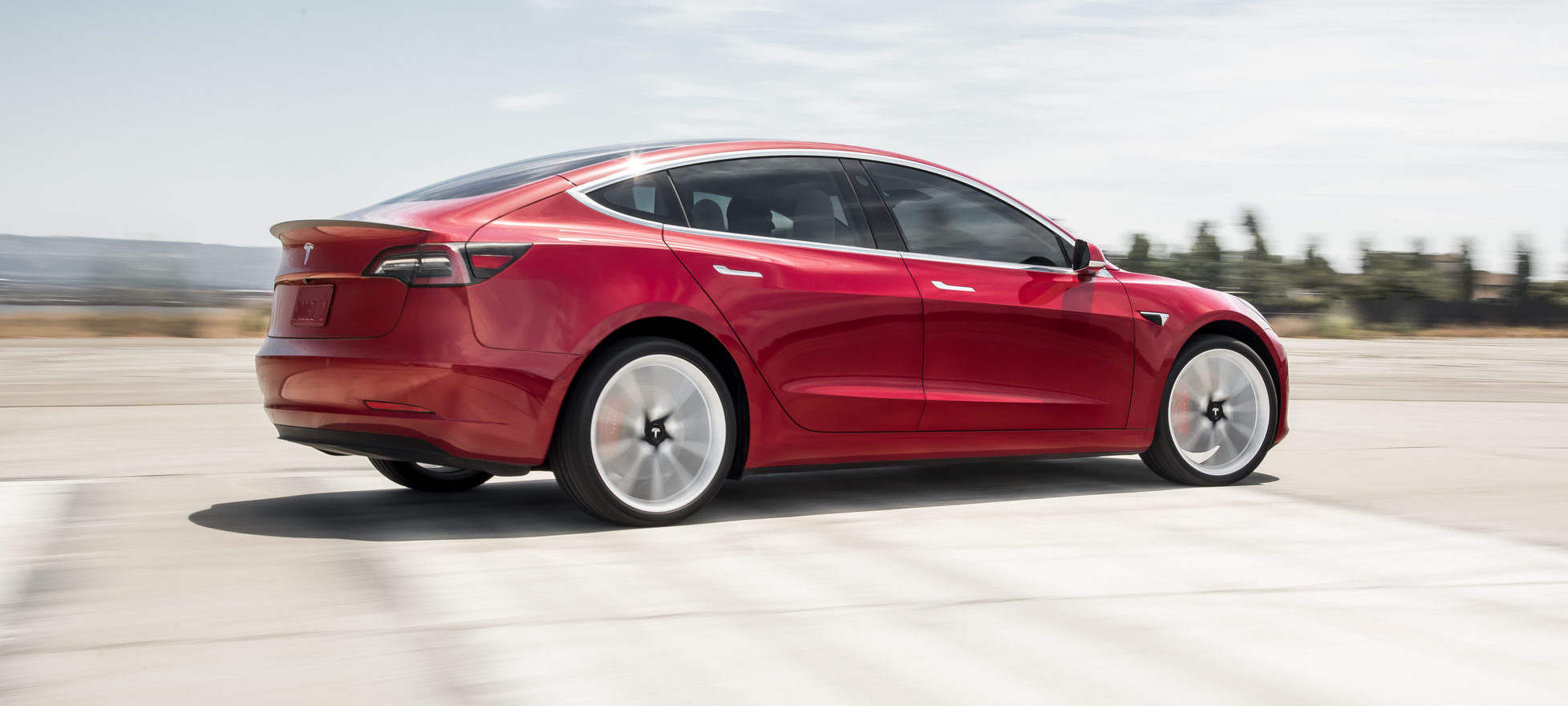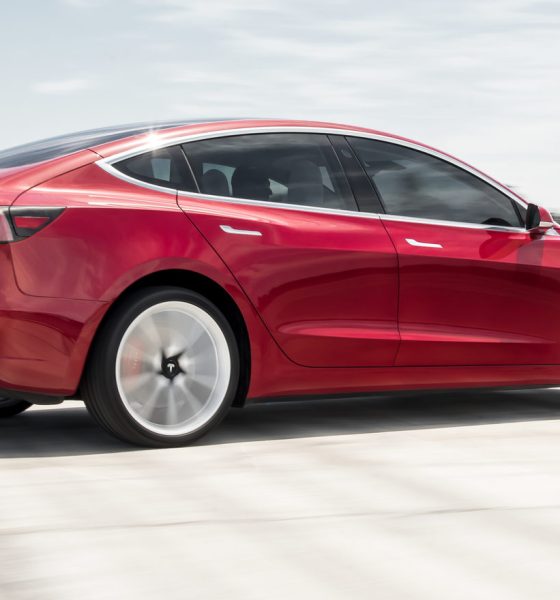

Investor's Corner
Tesla impresses skeptical Wall St analyst after Model 3 Performance test drive
One of Tesla’s most ardent bulls who adopted a more skeptical stance on the company earlier this year has seemingly been won over after a test drive in the Model 3 Performance. In a recent note, Morgan Stanley analyst Adam Jonas wrote that the Model 3 Performance is impressive, being a vehicle that signifies a positive momentum for electric cars as a whole.
In his note, Jonas stated that workers at the Fremont factory continue to be incredibly busy manufacturing the electric car to meet the demand for the vehicle in the United States. The Morgan Stanley analyst also pointed out that the Model 3 Performance seems to be the best bang-for-the-buck electric car in Tesla’s lineup, giving even more value-for-performance than the Model S 75D.
“Frankly, our enjoyment of the high-spec version of the Model 3 took us by surprise. It’s hard to say how much this matters. But it matters,” Jonas stated.
Overall, Jonas outlined several factors driving expectations for electric cars today, including positive regulatory initiatives in large markets such as China and Europe, the rising price of oil, as well as the increasing number of companies looking into electrified vehicles. These factors, particularly the regulatory initiatives from several regions across the globe, are starting to be felt by legacy carmakers, including Volkswagen AG, which recently expressed its reservations about the EU’s proposal to reduce emissions by 35% on or before 2030.
Morgan Stanley has historically adopted a bullish stance on Tesla stock (NASDAQ:TSLA), though last May, Jonas cut the company’s price target from $376 to $291 – a 23% decrease. Jonas also slashed his long-term operating profit margin forecast for the electric car maker from 14.3% to 9.8%. Explaining his more conservative stance in a note, Jonas wrote that the “lingering manufacturing issues with the Model 3 – most recently at Fremont final assembly” could prevent Tesla from achieving its ambitious self-imposed targets.
“The challenges in ramping up Model 3 production reflect fundamental issues of vehicle design, manufacturing process, and automation levels that can weigh against the profitability of the vehicle,” Jonas wrote.
Just last month, Jonas also released a note stating that Tesla would likely initiate an equity raise of $2.5 billion in Q4 2018. While the analyst did acknowledge the bull thesis that Tesla would not need to raise equity if it generates enough cash, Jonas nonetheless stated that “it is far better for a company to raise when it doesn’t need to.” Considering the Morgan Stanley analyst’s recent note, though, it appears that Adam Jonas might adopt a more optimistic outlook on Tesla once more.
Since ending Q3 2018 with a delivery blitz that resulted in a total of 83,500 vehicles being handed over to customers before September ended, Tesla appears to be going full throttle in its ongoing efforts to ramp the production of the Model 3. Even before Q3’s end, reports already emerged that Gigafactory 1 in Nevada is receiving upgrades in Q4, in the form of new Grohmann machines that can make “module production become three times faster, and three times cheaper.” New battery cell production lines from Panasonic, which were initially scheduled to go online by the “end of 2018,” are set to be completed earlier than expected as well.
Tesla has been mostly quiet about its progress this Q4 so far, but the company has been showing encouraging signs of a strong production ramp. In the first two weeks of October, for example, Tesla registered more than 30,000 new Model 3 VINs, including a record batch of more than 9,000 vehicles in one filing. In a recent announcement, Tesla CEO Elon Musk also revealed that despite the company’s restructuring earlier this year, Tesla now employs a workforce of around 45,000 employees.
Disclosure: I have no ownership in shares of TSLA and have no plans to initiate any positions within 72 hours.

Investor's Corner
Tesla stock closes at all-time high on heels of Robotaxi progress

Tesla stock (NASDAQ: TSLA) closed at an all-time high on Tuesday, jumping over 3 percent during the day and finishing at $489.88.
The price beats the previous record close, which was $479.86.
Shares have had a crazy year, dipping more than 40 percent from the start of the year. The stock then started to recover once again around late April, when its price started to climb back up from the low $200 level.
This week, Tesla started to climb toward its highest levels ever, as it was revealed on Sunday that the company was testing driverless Robotaxis in Austin. The spike in value pushed the company’s valuation to $1.63 trillion.
Tesla Robotaxi goes driverless as Musk confirms Safety Monitor removal testing
It is the seventh-most valuable company on the market currently, trailing Nvidia, Apple, Alphabet (Google), Microsoft, Amazon, and Meta.
Shares closed up $14.57 today, up over 3 percent.
The stock has gone through a lot this year, as previously mentioned. Shares tumbled in Q1 due to CEO Elon Musk’s involvement with the Department of Government Efficiency (DOGE), which pulled his attention away from his companies and left a major overhang on their valuations.
However, things started to rebound halfway through the year, and as the government started to phase out the $7,500 tax credit, demand spiked as consumers tried to take advantage of it.
Q3 deliveries were the highest in company history, and Tesla responded to the loss of the tax credit with the launch of the Model 3 and Model Y Standard.
Additionally, analysts have announced high expectations this week for the company on Wall Street as Robotaxi continues to be the focus. With autonomy within Tesla’s sights, things are moving in the direction of Robotaxi being a major catalyst for growth on the Street in the coming year.
Elon Musk
Tesla needs to come through on this one Robotaxi metric, analyst says
“We think the key focus from here will be how fast Tesla can scale driverless operations (including if Tesla’s approach to software/hardware allows it to scale significantly faster than competitors, as the company has argued), and on profitability.”

Tesla needs to come through on this one Robotaxi metric, Mark Delaney of Goldman Sachs says.
Tesla is in the process of rolling out its Robotaxi platform to areas outside of Austin and the California Bay Area. It has plans to launch in five additional cities, including Houston, Dallas, Miami, Las Vegas, and Phoenix.
However, the company’s expansion is not what the focus needs to be, according to Delaney. It’s the speed of deployment.
The analyst said:
“We think the key focus from here will be how fast Tesla can scale driverless operations (including if Tesla’s approach to software/hardware allows it to scale significantly faster than competitors, as the company has argued), and on profitability.”
Profitability will come as the Robotaxi fleet expands. Making that money will be dependent on when Tesla can initiate rides in more areas, giving more customers access to the program.
There are some additional things that the company needs to make happen ahead of the major Robotaxi expansion, one of those things is launching driverless rides in Austin, the first city in which it launched the program.
This week, Tesla started testing driverless Robotaxi rides in Austin, as two different Model Y units were spotted with no occupants, a huge step in the company’s plans for the ride-sharing platform.
Tesla Robotaxi goes driverless as Musk confirms Safety Monitor removal testing
CEO Elon Musk has been hoping to remove Safety Monitors from Robotaxis in Austin for several months, first mentioning the plan to have them out by the end of 2025 in September. He confirmed on Sunday that Tesla had officially removed vehicle occupants and started testing truly unsupervised rides.
Although Safety Monitors in Austin have been sitting in the passenger’s seat, they have still had the ability to override things in case of an emergency. After all, the ultimate goal was safety and avoiding any accidents or injuries.
Goldman Sachs reiterated its ‘Neutral’ rating and its $400 price target. Delaney said, “Tesla is making progress with its autonomous technology,” and recent developments make it evident that this is true.
Investor's Corner
Tesla gets bold Robotaxi prediction from Wall Street firm
Last week, Andrew Percoco took over Tesla analysis for Morgan Stanley from Adam Jonas, who covered the stock for years. Percoco seems to be less optimistic and bullish on Tesla shares, while still being fair and balanced in his analysis.

Tesla (NASDAQ: TSLA) received a bold Robotaxi prediction from Morgan Stanley, which anticipates a dramatic increase in the size of the company’s autonomous ride-hailing suite in the coming years.
Last week, Andrew Percoco took over Tesla analysis for Morgan Stanley from Adam Jonas, who covered the stock for years. Percoco seems to be less optimistic and bullish on Tesla shares, while still being fair and balanced in his analysis.
Percoco dug into the Robotaxi fleet and its expansion in the coming years in his latest note, released on Tuesday. The firm expects Tesla to increase the Robotaxi fleet size to 1,000 vehicles in 2026. However, that’s small-scale compared to what they expect from Tesla in a decade.
Tesla expands Robotaxi app access once again, this time on a global scale
By 2035, Morgan Stanley believes there will be one million Robotaxis on the road across multiple cities, a major jump and a considerable fleet size. We assume this means the fleet of vehicles Tesla will operate internally, and not including passenger-owned vehicles that could be added through software updates.
He also listed three specific catalysts that investors should pay attention to, as these will represent the company being on track to achieve its Robotaxi dreams:
- Opening Robotaxi to the public without a Safety Monitor. Timing is unclear, but it appears that Tesla is getting closer by the day.
- Improvement in safety metrics without the Safety Monitor. Tesla’s ability to improve its safety metrics as it scales miles driven without the Safety Monitor is imperative as it looks to scale in new states and cities in 2026.
- Cybercab start of production, targeted for April 2026. Tesla’s Cybercab is a purpose-built vehicle (no steering wheel or pedals, only two seats) that is expected to be produced through its state-of-the-art unboxed manufacturing process, offering further cost reductions and thus accelerating adoption over time.
Robotaxi stands to be one of Tesla’s most significant revenue contributors, especially as the company plans to continue expanding its ride-hailing service across the world in the coming years.
Its current deployment strategy is controlled and conservative to avoid any drastic and potentially program-ruining incidents.
So far, the program, which is active in Austin and the California Bay Area, has been widely successful.








